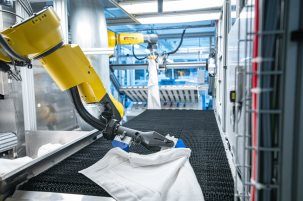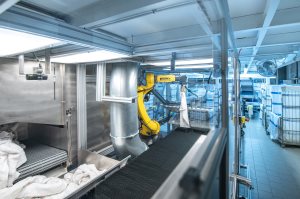
In the industrial laundry sector, automation has made it possible to process up to 100 tons of textiles per day, almost entirely without human intervention. However, until recently, loading towels or bed sheets into laundry folding machines was still a genuinely manual task. This is where Sewts, a Munich-based start-up, comes in with its new robot system, VELUM, that can perform this task without causing creases.
"The market potential is significant," explains Sewts co-founder Till Rickert. He estimates that there are around 25,000 laundry businesses worldwide that could benefit from the technology. The first VELUM systems have already been installed, with customer Greif Textile Mietsysteme in Wolfratshausen, Bavaria, using the system since November 2022.
The robot system processes an average 500 to 600 textiles per hour, automating a task previously performed manually. Currently, the performance of the VELUM system is comparable to that of a human operator, but with continuous over-the-air software updates, the system's range of functions is continuously expanding, improving its efficiency. Depending on the workload, the VELUM pays for itself after one and a half to two and a half years, according to Rickert.
"One initial challenge was the tight installation space in which very fast movements have to be executed", explains Rickert. Sewts used two simulation tools during development. FANUC ROBOGUIDE software to analyse robot movements and space requirements, and advanced material simulation software to simulate the behaviour of different types of textiles. The system installed in Wolfratshausen uses two FANUC M-10iD robots with a payload of 12 kg and a range of 1,400 mm.
 The VELUM system's centrepiece is its intelligent software that can analyse deformable materials and predict their behaviour when gripped. When combined with a FANUC robot and a 3D camera system, the software can identify textures, seams, and corners of individual textiles, locate them in space, and create control commands, enabling the robot to grasp textiles at an ideal point in real-time.
The VELUM system's centrepiece is its intelligent software that can analyse deformable materials and predict their behaviour when gripped. When combined with a FANUC robot and a 3D camera system, the software can identify textures, seams, and corners of individual textiles, locate them in space, and create control commands, enabling the robot to grasp textiles at an ideal point in real-time.
Sewts plans to increase the number and performance of VELUM systems gradually. The start-up is already working on the next innovations, robots with vision systems to process textile returns for large online retailers in the future. Due to labour shortages, such returns are often processed in far-away countries, resulting in long transport routes and wasted goods. "In the future, thanks to automation, such processes could take place close to the customer," Rickert hopes.